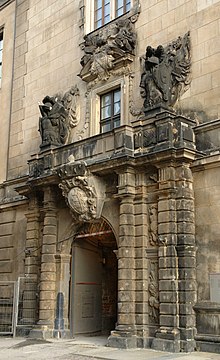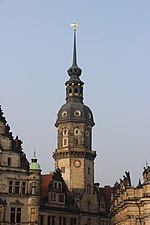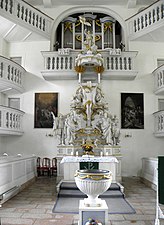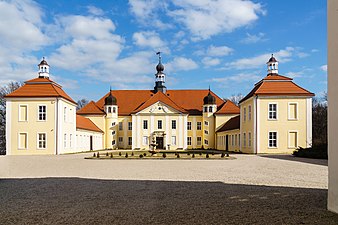Wolf Caspar von Klengel
Wolf Caspar Klengel , von Klengel since 1664 , (born June 8, 1630 in Dresden ; † January 10, 1691 ibid) was a German architect and senior construction officer from the Electorate of Saxony .
family

The builder Wolf Caspar von Klengel was born in 1630 as the son of the electoral councilor and chief tax accountant Caspar Klengel and his wife Sabina Elisabeth born. Fisher born. Klengel's maternal grandparents were the captain of the Saxon bodyguard Wolfgang Fischer and the granddaughter of the famous court architect Paul Buchner, who worked in Saxony .
Wolf Caspar was the middle-most of the family's three sons. The eldest brother, D. Christian Klengel , became the Saxon consistorial assessor and the youngest, Carl Klengel, is mentioned as an officer.
The fifteen years younger Marie von Bex (1645-1717), daughter of the Leipzig councilor Franz von Bex auf Nischwitz and his wife Gertrud Avenbeck, married Klengel on July 23, 1662. He was married to her for twenty-nine years. The couple had four sons and four daughters; Marie Elisabeth, Hans Caspar, Hans Philipp, Franz Ludwig, Hans Rudolph, Anna Sophie, Sophie Eleonore and Johanne Margarete. It is known about the sons that they served in the Saxon military. Daughter Marie Elisabeth became the wife of Hans Rüdiger von Schönfeld, Anna Sophie died as a child, Sophie Eleonore was lady-in-waiting to the Electress Anna Sophie and initially the wife of the chief kitchen master Hans Adolph von Haugwitz . After his death she married the privy councilor Rudolph Gottlob Freiherr von Seyffertitz. Her youngest sister, Johanne Margarete, married Georg Joseph Anton Freiherr von Cloß auf Heydeburg.
Life
Wolf Caspar von Klengel had a thorough education at middle school level or even high school level. As part of the privately organized training, he learned good Latin and Greek as well as mathematics and drawing as modern subjects.
At a young age, on June 2, 1647, Klengel set out on his first trip abroad. It led him via Hamburg to Amsterdam , Leyden and The Hague . Via Brussels he reached Paris on May 16, 1648 , where he attended the military academy of the Duc de Beaufort during the summer. In addition to training in military engineering, he learned French and also dealt with contemporary journalism. He briefly returned to Dresden in 1650 via Rouen and Hamburg.
In 1651 Klengel set out on a long three-year trip to Italy that took him to Venice , Florence and Rome . In Rome he made friends with the famous Jesuit and polymath Athanasius Kircher .
After his return from Italy he was first appointed Oberlandbaumeister in Dresden in 1656 and later, in 1672, Chief Inspector of Civil and Military Buildings under the Saxon Electors Johann Georg II. (1613–1680) and Johann Georg III. appointed. He also acted as a supervisor of the electoral art chamber until his death, for which he purchased numerous works, including a painting by Peter Paul Rubens .
On April 16, 1664, Wolf Caspar was raised to the imperial nobility by Emperor Leopold I together with his brothers .
After his death, Wolf Caspar von Klengel was honored with a tomb he designed himself in the Sophienkirche in Dresden . After her death, his widow left 10,000 thalers from their joint property for a foundation in favor of converts to the Evangelical Lutheran faith and for Protestant religious refugees .
Klengel is considered to be the founder of Saxon baroque architecture and, in terms of art history, was the most important Saxon master builder in the 17th century alongside his subordinate Johann Georg Starcke . Significant parts of his drawings are now in Stuttgart.
Works

Klengel's first major project was to refurbish the electoral living and representation rooms in the west wing of the Dresden Residenzschloss . Some design drawings and small remains of the stucco furnishings have survived.
From 1664 to 1667 Klengel built the first permanent opera house in the royal city, the opera house on Taschenberg, next to the residential palace in Dresden .
From 1667 to 1669 he built the Johann Georgen bastion in front of the Georgenburg at Königstein Fortress and refurbished the St. George's Chapel , built in 1515, from 1671 to 1676 (tower, roof, altar, pulpit).
In 1672 he built the chapel of Moritzburg Castle and created the furnishings that are still preserved today. Further works are the high house (today Spitzhaus) above the Hoflößnitz , in 1674/76 the elevation of the Hausmannsturm of the Dresden Residenzschloss including a baroque hood, in 1677/78 the electoral riding house at the Dresden Castle. Shortly before his death, he started the Green Gate on the north side of the Hausmannsturm.
Between 1675 and 1686 the electoral court stud Bleesern near Wittenberg and 1684–1688 the Trinity Church in Carlsfeld near Eibenstock in the Ore Mountains was built according to his design .
Probably Klengel also designed the building plan for the manor house of the Hohenprießnitz manor , which his brother Christian von Klengel (1629-93) had built in 1677-78, as well as for the village church in Eutzsch near Wittenberg, which was built in 1688 on behalf of the Wittenberg University. He was probably also involved in the design of the palace in the Great Garden in the 1670s , as there are numerous architectural motifs he liked to use here.
In 1688 he was in command of Sonnenstein Castle near Pirna and had it expanded into a fortress.
photos
Trinity Church in Carlsfeld
Hohenprießnitz Castle
Individual evidence
- ↑ Fundamental to his biography: Günter Passavant: Wolf Caspar von Klengel, Dresden 1630–1691. Travel - sketches - architectural activities . Munich / Berlin 2001.
- ↑ Passavant 2001.
literature
general

- Günter Passavant: Wolf Caspar von Klengel, Dresden 1630–1691. Travel - Sketches - Architectural Activities, Munich / Berlin 2001, ISBN 3-422-06299-8 . (fundamental)
- Walter May : Klengel, Wolf Caspar von. In: New German Biography (NDB). Volume 12, Duncker & Humblot, Berlin 1980, ISBN 3-428-00193-1 , pp. 40-42 ( digitized version ).
- Viktor Hantzsch : Klengel, Wolf Caspar von . In: Allgemeine Deutsche Biographie (ADB). Volume 51, Duncker & Humblot, Leipzig 1906, pp. 209-212.
- Ernst Sigismund : A Saxon artist and soldier of the 17th century [Klengel] , in: Dresdner Geschichtsblätter 12 (1913), No. 3, pp. 33–56.
- Bernhard Schmied: A troubled but undaunted Christian's insurmountable hope for God Bey the high-snouted corpse = Begängnüß of the well-bored Mr. Wolf Caspars von Klengel. Dresden [1691]. on-line
special topics
- Eberhard Hempel : Unknown sketches by Wolf Caspar von Klengel , in: Treatises of the Saxon Academy of Sciences in Leipzig. Phil.-hist. Class, Vol. 59, No. 4, Berlin 1958.
- Hermann Heckmann : Builders of the Baroque and Rococo in Saxony , Berlin 1996, pp. 32–43.
- Mario Titze: Building history and structure of the Trinity Church in Carlsfeld in the Erzgebirge , in: Die Dresdner Frauenkirche , Yearbook Vol. 3, Weimar 1997, pp. 131–141.
- Mario Titze: The former electoral Saxon stud Bleesern. A building by Wolf Caspar von Klengels , in: Denkmalpflege in Sachsen-Anhalt , 1998/1, pp. 53–59.
- Stephan Reinert: The former Landsberger Spitzhaus - a building by Wolf Caspar von Klengels? In: Heinrich Magirius (Ed.): 600 years Hoflößnitz. Historical winery complex . Sandstein Verlag, Dresden 2001, ISBN 3-930382-60-1 , p. 105-109 .
- Mario Titze: New research on Vorwerk Bleesern, Ldkr. Wittenberg , in: Burgen und Schlösser in Sachsen-Anhalt , Issue 11/2002, pp. 368–383.
- Prof. Dr. Ernst Heinrich Kneschke : New General Adelslexikon, Fifth Volume , Kalb-Loewenthal, Leipzig 1864, pp. 130-131.
- Königlich Sächsischer Altertumsverein: Mittheilungen des Königlich-Sächsischer Alterthumsverein, Volume 22 , Dresden 1872, Pages 29-30.
- Johannes Georg Zirschke: Reliable description of the high generals or detailed reports from the high military servants who served the House of Saxony since 1680, first continuation of the 2nd part of the royal war state of Electoral Saxony , Görlitz 1756, pages 266-268.
Web links
- Literature by and about Wolf Caspar von Klengel in the catalog of the German National Library
- Publications by and about Wolf Caspar von Klengel in VD 17 .
- Information on Dresden in the early baroque and from Klengel
| personal data | |
|---|---|
| SURNAME | Klengel, Wolf Caspar von |
| BRIEF DESCRIPTION | Master builder from Saxony |
| DATE OF BIRTH | June 8, 1630 |
| PLACE OF BIRTH | Dresden |
| DATE OF DEATH | January 10, 1691 |
| Place of death | Dresden |







